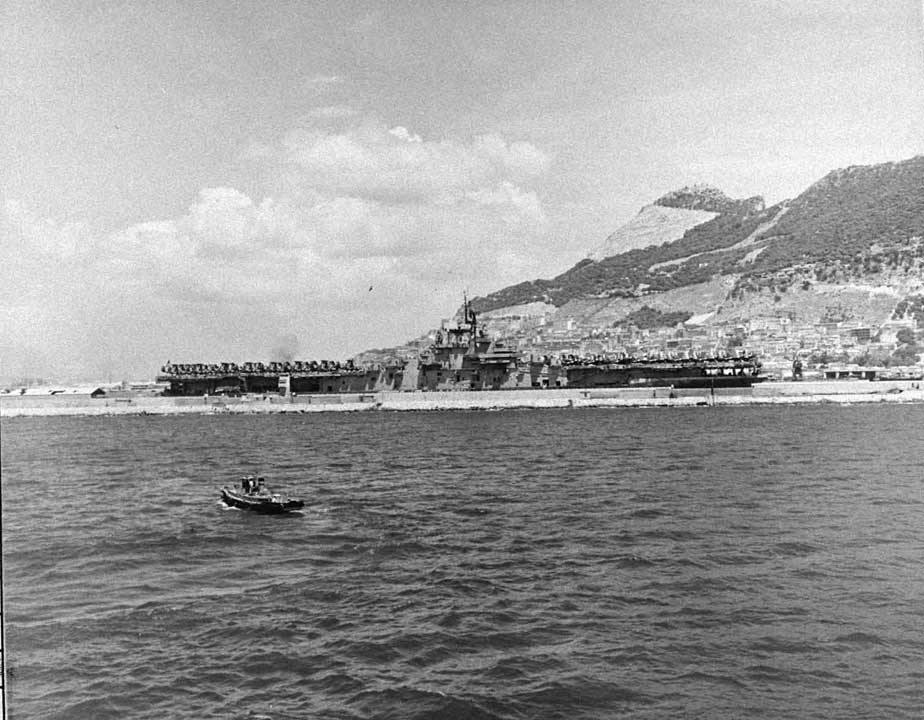
(Displacement: 27,100 tons length: 888 feet beam: 93 feet; extreme width at flight deck: 147 feet draft: 28 feet speed: 32.7 knots complement: 3,448 crew armament: 12 5-inch guns, 72 40mm guns class: Essex
Construction and Commissioning:
The first USS Tarawa (CV-40) was laid down on 1 March 1944 at the Norfolk Navy Yard. She was launched on 12 May 1945, sponsored by Mrs. Julian C. Smith, the wife of Lieutenant General Julian C. Smith, USMC, who commanded the 2nd Marine Division at Tarawa. The ship was commissioned on 8 December 1945, with Captain Alvin Ingersoll Malstrom in command.
Early Service:
Tarawa remained in the Norfolk area until 15 February 1946, when she sailed for shakedown training near Guantanamo Bay, Cuba. She briefly returned to Norfolk on 16 April, visited New York later that month, and came back to Norfolk on 30 April. After completing her post-shakedown overhaul in late June, she departed Hampton Roads on 28 June for the west coast, transiting the Panama Canal in early July and arriving in San Diego on 15 July 1946.
Western Pacific Deployment:
Following training and upkeep, Tarawa left San Diego for the western Pacific, reaching Pearl Harbor on 7 August. After arriving at Saipan on 20 August, she operated in the Mariana Islands until late September, then headed to Japan, stopping at Yokosuka and Sasebo. She then proceeded to the northern coast of China, operating near Tsingtao until the end of October before returning to the Marianas.
Post-War Operations:
From 7 November 1946, Tarawa operated in the Marianas, with a brief trip to Okinawa in January 1947. She then returned to Pearl Harbor and participated in fleet exercises near Kwajalein. After more training in the Hawaiian Islands, she headed for the west coast, arriving in San Francisco on 29 April 1947. Over the next 16 months, she conducted air operations out of San Francisco and San Diego.
Around-the-World Cruise:
On 28 September 1948, Tarawa embarked on an extensive cruise, visiting Tsingtao, China; Hong Kong; Singapore; and Colombo, Ceylon, among other ports. She transited the Suez Canal in January 1949, visited Greece, Turkey, and Crete, and returned to Norfolk on 21 February 1949. After a period of normal operations along the east coast and in the Caribbean, she was placed out of commission on 30 June 1949 and berthed with the Atlantic Reserve Fleet in New York.
Korean War Reactivation:
Tarawa was reactivated on 30 November 1950 due to the Korean War. She was recommissioned on 3 February 1951 but did not see combat in Korea. Instead, she served with the 6th and 2nd Fleets as a replacement for carriers sent to the war zone. On 1 October 1952, she was redesignated as an attack aircraft carrier (CVA-40).
Cold War Service:
In the spring of 1954, Tarawa operated in the Far East, including a deployment long after the Korean War armistice. She returned to the east coast later that year and underwent conversion to an antisubmarine warfare (ASW) aircraft carrier, redesignated CVS-40 on 10 January 1955. She operated mainly in the Atlantic, conducting barrier patrols and training missions until her decommissioning in May 1960.
Final Years and Decommissioning:
Tarawa was placed in reserve in Philadelphia and redesignated AVT-12 in May 1961. She was struck from the Navy list on 1 June 1967 and sold for scrapping on 3 October 1968.
Throughout her service, USS Tarawa played a significant role in various naval operations, adapting to changing military needs and serving both in combat and training capacities.
